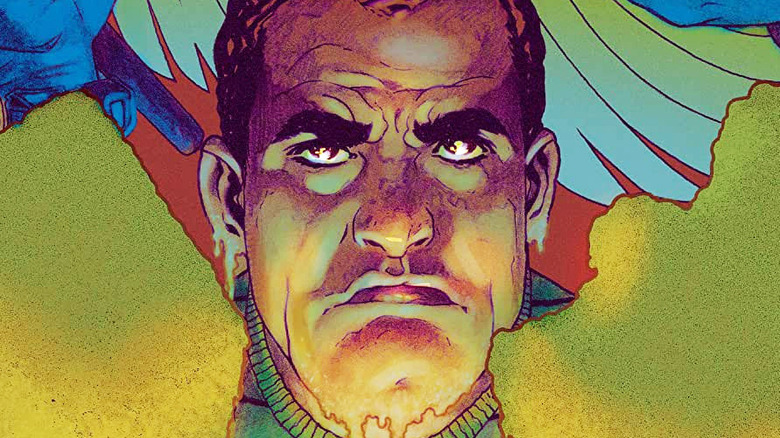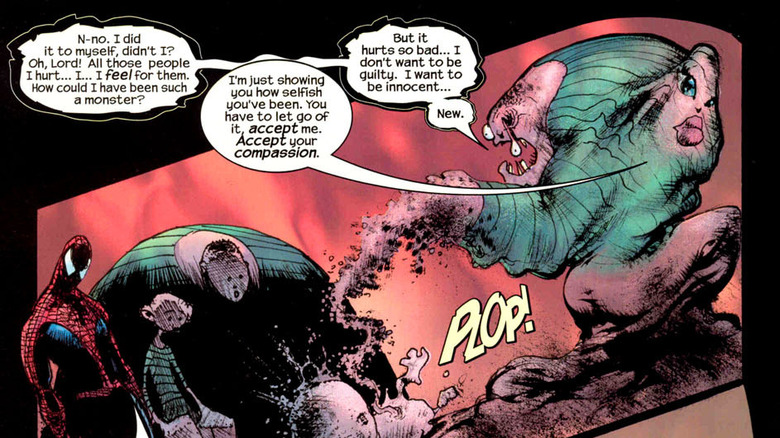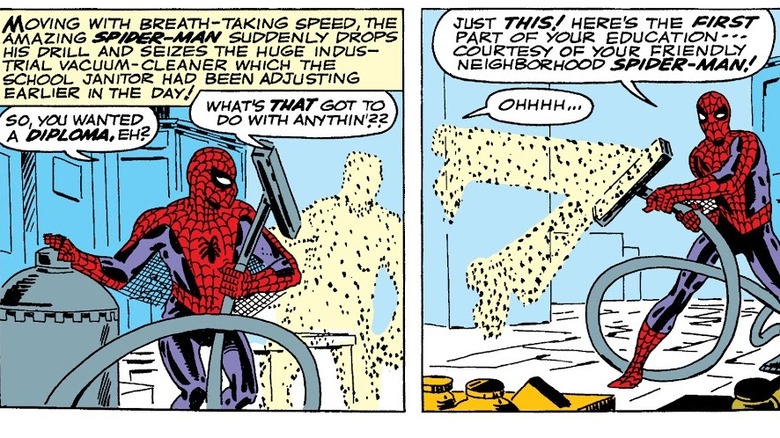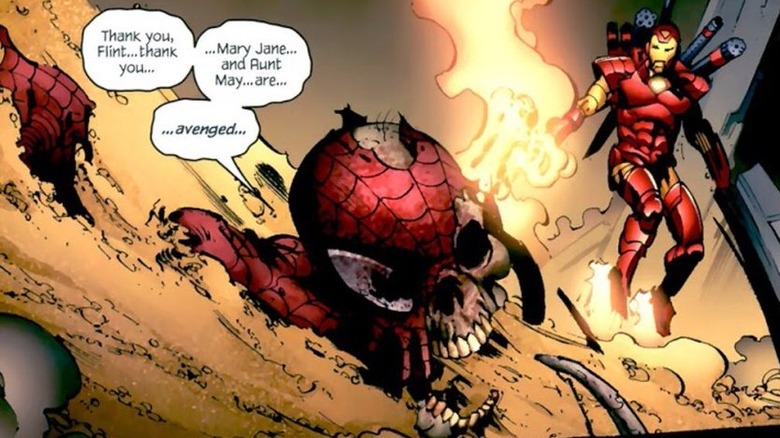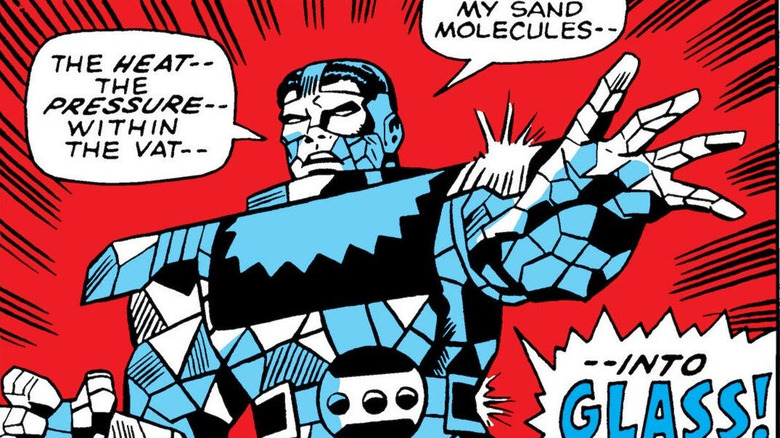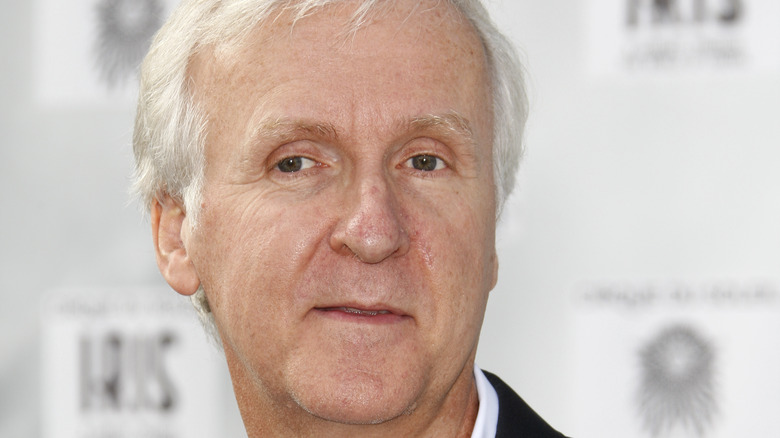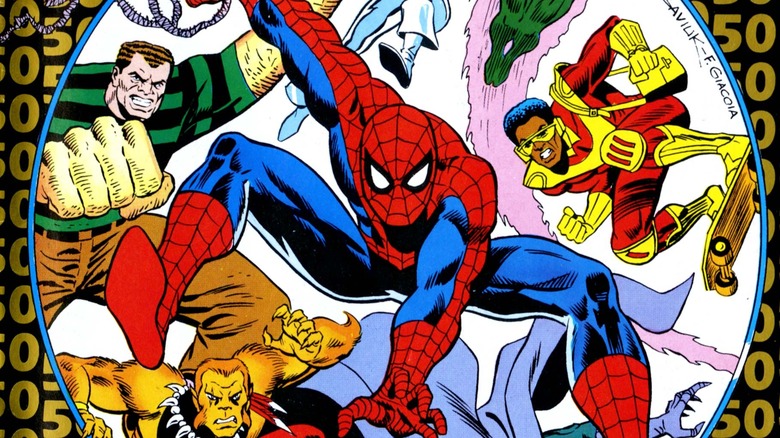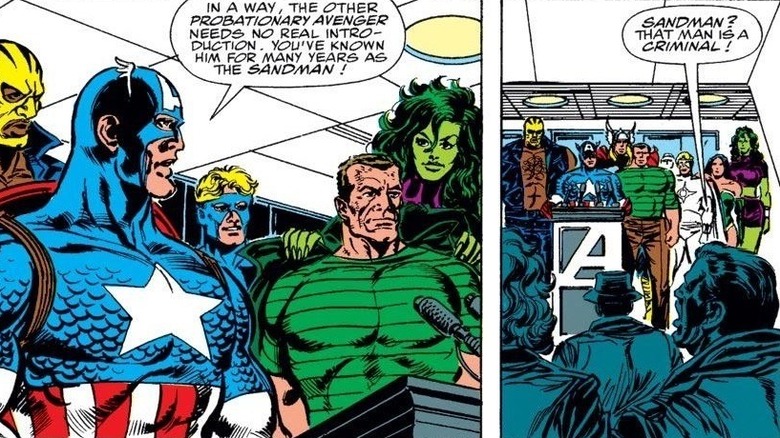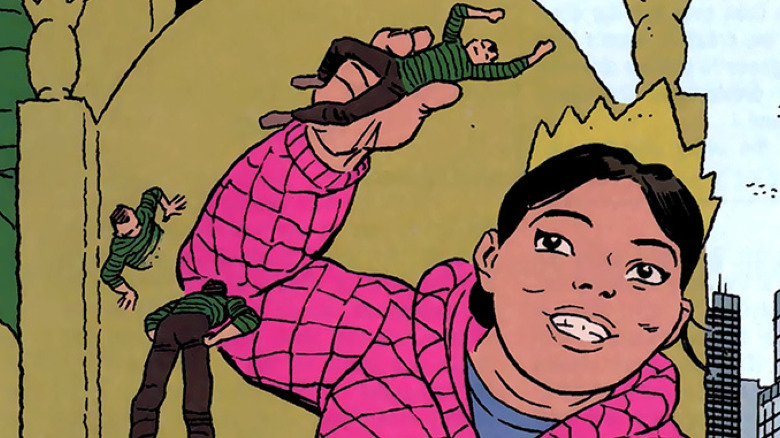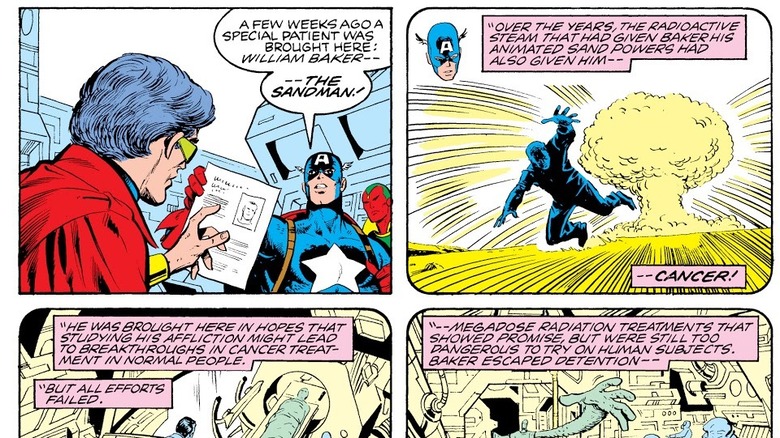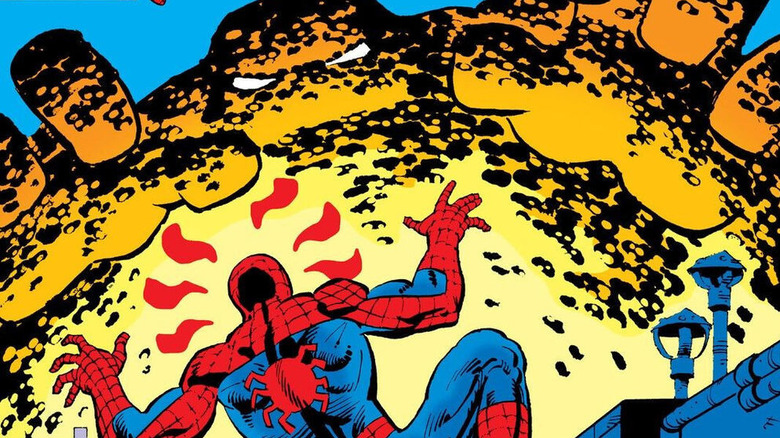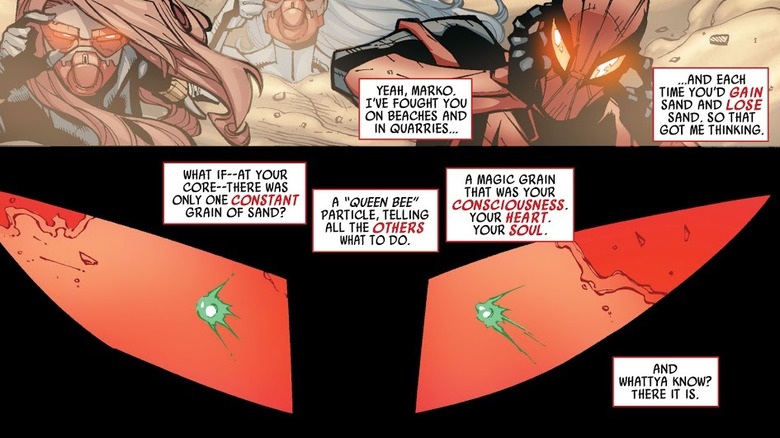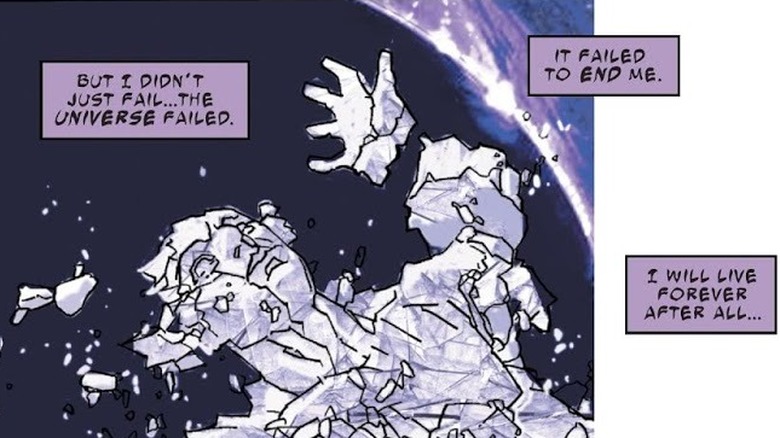The Untold Truth Of Marvel's Sandman
It's often said that a hero is defined by his villains. By this measure, it's no surprise that Spider-Man has one of the best rogues galleries in all of comics. Many of the wallcrawler's most fearsome foes are complex individuals whose tragic backgrounds drove them to a life of crime. Few of this number are as complicated as Flint Marko, the Sandman.
After unintentionally coming into contact with irradiated sand at a nuclear testing site, Flint transforms into a living, breathing organism made of sand. Because of the Sandman's uncanny ability to change his size, shape, and hardness at will, Spider-Man typically needs more than his usual punches, kicks, and webbing in order to beat him.
It's easy to look at the Sandman and dismiss him as little more than a monster. However, his rich character history paints a picture of a conflicted soul who could have been a full-fledged hero himself, if things had worked out differently. This is the untold truth of Marvel's Sandman.
The Sandman has multiple personalities
The Sandman made his debut in the pages of 1963's "Amazing Spider-Man" #4. Here, he's introduced as an escaped inmate who happens to be in the wrong place at the wrong time. Later stories reveal that his real name is actually William Baker: Flint Marko is merely his criminal codename, partially inspired by the name of a teacher from his past.
Beyond this alternate alias, the Sandman actually has separate personalities inside him. In 2003's "Peter Parker: Spider-Man" #56, the different facets of the Sandman's personality physically split into separate beings, all working independently of one another. The next issue sees Spider-Man team up with the Sandman's conscientious, childlike, and feminine personas in order to apprehend his evil self, who has been causing trouble in a different part of the city. In the end, all the disparate aspects of the Sandman's personality, save for his conscience, successfully merge, creating a single, villainous Sandman once more.
The Sandman loses his first fight with Spider-Man on purpose
The Sandman's first tussle with the webslinger in "Amazing Spider-Man" #4 is a memorable encounter, largely due to the hero's unconventional strategy: He subdues the Sandman by sucking up the villain's particles with a vacuum cleaner. However, it's revealed in a flashback issue that the only reason this works is because Sandman allows it to work.
Getting caught is part of Flint's plan to help his father, Floyd Baker, escape from prison. He has correctly anticipated that the authorities will send him to the same facility, and thus wants to use the opportunity to break him and his father out of jail. The Sandman succeeds in his quest, but not before Spider-Man tracks him down and defeats him (with a little help from the rain and some lightning). His father slips away in the chaos, living life as a free man for many years.
Some time later, the Sandman's father is sentenced to death for murder. His alleged victim is a version of Spider-Man's Uncle Ben from an alternate reality. Flint asks for Spider-Man's help in exonerating his father — during this time, Peter Parker's dual identity is public knowledge — and eventually, the two enemies track down the real killer: The Chameleon of the year 2211. They manage to save the Sandman's father by pulling a last-minute switch, swapping the Chameleon for Floyd at the precise moment of his execution.
In an alternate universe, the Sandman kills Spider-Man horribly — twice
The twisted Marvel Zombies reality came into existence when a zombified version of the Sentry infected the heroes and villains of his world. Among the heroes who manage to leave this blighted planet are an undead Spider-Man, who's eaten his Aunt May and Mary Jane. The zombified wall-crawler ends up in a different reality, one completely devoid of zombies — prior to his arrival, that is.
When he comes face to face with the Sinister Six of that world — the classic roster of Doctor Octopus, Kraven the Hunter, the Sandman, Mysterio, Electro, and the Vulture — he makes short work of most of them by straight-up eating their organs. Only the Sandman is able to survive this vicious assault, and is thoroughly shocked by the alternate webslinger's actions. He soon encounters his world's version of Spider-Man, whom he mistakes for the zombie. Driven by rage and self-preservation, he beats the hero to a pulp and forcefully enters his mouth, blowing him up from the inside.
Seeking to atone for murdering his loved ones (and wanting to prevent the zombie virus from reaching other worlds), the zombified Spider-Man captures the Sandman and bombards him with disease-consuming nanobots. In a climactic battle, the weaponized Sandman is unleashed upon the zombies, obliterating nearly all of the remaining undead, including zombie Spider-Man himself. The only zombie super-being spared from this fate is the Sentry, who the Watcher has trapped in a time loop.
The Sandman can survive being turned into glass
At extremely high temperatures, ordinary sand can turn into glass. As one might imagine, this can be a major problem for a silica-based criminal who regularly dukes it out with superpowered do-gooders. On more than one occasion, the Sandman has experienced just how difficult this predicament truly is — and subsequently discovered that he can, in fact, survive a transformation into glass.
In 1969's "Incredible Hulk" #114, a fierce battle between the Hulk and the Sandman ends with the latter getting knocked into a pressurized vat. This turns the villain into a being of pure glass, which means he won't be able to survive even a single punch from the green behemoth. Realizing this, the Hulk spares the Sandman's life. It takes assistance from the Wizard and a blood transfusion from Betty Ross to restore the Sandman to his sandy state.
Years later, Doctor Octopus turns the Sandman into glass and shatters his body in an attempt to take him out of commission as the newly reformed Sinister Six set their sights on conquering the world. Fortunately, Flint is able to will himself into becoming whole once again, but with a slight catch: He turns into a bipedal monster composed entirely of glass shards. In this dangerous new form, the Sandman manages to critically injure Doctor Octopus. However, Spider-Man stops him before he can finish the job, and subsequently uses the villainous scientist's technology to turn Flint back into sand.
A movie that never materialized left the Sandman off-limits for TV
1994's "Spider-Man: The Animated Series" introduced the web-slinging superhero and his universe to a whole new generation of fans. It is widely considered to be one of the best animated superhero series ever made, even decades after its conclusion. Still, it makes a few notable omissions — one of them being the Sandman, whose status as an A-list Spider-Man villain makes his absence even more glaring.
As it turns out, the shape-shifting villain is never seen throughout the show's five seasons for one simple reason: He and fellow Sinister Six member Electro were supposed to be the villains in a Spider-Man film director James Cameron was then attempting to make. In the planned (and ultimately scrapped) movie, both antagonists were set to be significantly different from their comic book counterparts. Electro was reimagined as Carlton Strand, an elite businessman with the ability to physically absorb computer data. The Sandman was demoted into being his lackey, simply named Boyd (via ScreenRant).
The project got fairly far in its development, but never actually made it to the screen. The cartoon's showrunners were able to add Electro to the final season, albeit with a different name and origin story from the source material. The Sandman, however, was not as fortunate. As series producer and story editor John Semper stated in an interview, "I never gave Sandman any thought because I just accepted that I wasn't able to use him and that was that."
The Sandman has been on numerous hero and villain teams
Over the years, Flint Marko's moral compass has been as malleable as his body. Despite being a pretty self-reliant criminal for most of his pre-Sandman career, Flint has proven to be a born team player, and has actually played on both sides of the superpowered fence.
The Sandman's best-known team affiliation is, without a doubt, the Sinister Six. First assembled by Doctor Octopus in 1964's "Amazing Spider-Man Annual" #1, Flint joins the team alongside Kraven the Hunter, Mysterio, Electro, and the Vulture. Even together, however, this super group still fails to defeat their hated wall-crawling foe. The Sandman is also a founding member of the Frightful Four, which made its debut in 1965's "Fantastic Four" #36. Alongside the Wizard, Paste-Pot Pete, and an amnesiac Medusa, the Sandman fights, as one might guess from the team's alliterative moniker, the Fantastic Four. At another point in his history, the Sandman teams up with the Enforcers against Spider-Man and the Human Torch.
To his credit, the Sandman has also tried to walk the straight and narrow path. For a time, he works under the leadership of Silver Sable as part of the Wild Pack. He even joins the Outlaws, Spider-Man's band of reformed criminals and anti-heroes. Most notably, he becomes a probationary member of the Avengers after receiving a presidential pardon. Sadly, his adventures as a superhero never quite seem to last, as Flint ultimately keeps returning to his villainous tendencies.
The Sandman has served as an Avenger
Given the Sandman's lengthy criminal record, his inclusion in Captain America's handpicked roster of Avengers in 1991's "Avengers" #329 comes as a surprise to many people in the Marvel universe. The reformed villain's mettle is tested almost immediately after the announcement of his membership is made, as the core Avengers team is suddenly whisked away by interdimensional entities. During this time, the Sandman becomes better acquainted with fellow probationary Avenger and newbie superhero Rage. Upon the team's return to the main universe, Captain America begins to train the two to help them improve as heroes.
Sadly, the Sandman's tenure on the team turns out to be short-lived, all because of a communication problem. After stopping a train theft with his teammates, the Sandman receives a bit of advice from Captain America. Flint gets the wrong idea, and thinks that Cap is kicking him off the team. He quickly leaves before the Star-Spangled Avenger can clarify the misunderstanding.
This isn't the last time the Sandman works with the Avengers, however. In 1998's "Avengers" #1, the Sandman temporarily rejoins his former teammates in fighting against the powerful magic-wielder, Morgan Le Fay. The Sandman also makes an appearance in the monumental 2003 crossover series "JLA/Avengers," which sees him pitch in to save both comic book universes from utter annihilation.
The Sandman has a daughter
In the dark, gritty future of Kaare Andrews' "Spider-Man: Reign" series, a much older Sandman discovers that he has a daughter named Susie. Partially taking after her father, the young girl has the ability to turn into cement. It is her tragic death that prompts the Sandman to make a final, heroic sacrifice, helping Spider-Man to reclaim New York City from its secretly Venom-possessed mayor.
The concept of the Sandman having a daughter is also explored in the 2007 film "Spider-Man 3," which came out after the last issue of "Spider-Man: Reign" hit the stands. In the movie, Flint Marko (played by Thomas Haden Church) becomes a small-time criminal because he needs money to pay for his daughter Penny's medical expenses. This leads to Flint accidentally killing Peter Parker's Uncle Ben — a fact he struggles to come to terms with, even after his transformation into the Sandman.
Sandman's daughter eventually found her way into mainstream comics continuity, but with a twist. 2009's "Amazing Spider-Man" #615 introduces Keemia Alvarado, a little girl Flint comes to love as his own daughter. The Sandman's dark side eventually manifests, however, and he ends up murdering the girl's mother out of jealousy. He does, however, remain fiercely loyal to Keemia, treating her like his own child and promising to gift her a diamond he's been planning to steal. Spider-Man apprehends the villain with Moon Knight's help, and Keemia is sent to a foster home.
The Sandman is a cancer survivor
It's a noticeable pattern in Silver Age comic books: Characters gain powers through some form of radiation, while the typical health consequences of such exposure remain unexplored. This isn't the case for the Sandman, though. As 1986's "Wonder Man" #1 reveals, the nuclear test that gave Flint Marko his powers also results in terminal cancer. Upon learning this, the Sandman hurries to the East Coast Medical Center for emergency treatment, bombarding himself with different degrees of radiation and potentially causing a nuclear meltdown. The Avengers send in Wonder Man, who promptly defeats the rampaging villain. Amazingly, his haphazard self-irradiation attempts work, sending his cancer into rapid remission.
Flint Marko's radioactive experiences actually end up having an unexpected perk: In addition to being cured of cancer, he has become virtually immune to radiation. This proves to be especially useful when he ends up fighting Avengers Academy recruit Hazmat, a young superhero with the power to emit lethal radiation blasts.
The Sandman once merged with another Spider-Man villain
When John Semper was informed he couldn't use the Sandman in "Spider-Man: The Animated Series," he simply used Hydro-Man instead. "There really isn't much difference between Sandman and Hydro-Man when you get right down to it," Semper remarked in an interview with Marvel Animation Age. "So look at the way I used Hydro-Man and you'll get a good idea of what I probably would have done with Sandman." Indeed, the two villains share quite a few similarities — and for a brief time in the comics, they share a body, too.
In 1981's "Amazing Spider-Man" #217, the Sandman and Hydro-Man come to blows after falling in love with the same woman. Spider-Man intervenes, but the battle goes awry when the two shape-shifting villains crash into each other and fall into the dockside waters. They become a single entity: A large, mindless "Mud-Thing" with incredible strength. This results in media attention for about two weeks, until authorities apparently spray it with a special gas that stops its sudden rampage.
1982's "Marvel Two-In-One" #86 reveals that authorities actually spend weeks trying to separate the two, but ultimately give up. After they leave the monster's remains at a city dumpsite, however, the treatments kick in, successfully freeing the Sandman and Hydro-Man from their amalgamation. Interestingly, it is at this point that Flint regrets his past actions. After having a drink with the Thing, he embarks upon the first of many attempts to reform himself.
The key to beating the Sandman is a single grain of sand
Due to the versatile nature of his powers, the Sandman is one of Spider-Man's most formidable foes. His full control over the sand particles that comprise his body makes it easy for him to withstand strong blows and deliver heavy hits of his own. However, he does have a few weaknesses. Water affects his body's consistency, and intense heat turns him into glass. After years of fighting him, Spider-Man even discovers his sandy enemy's Achilles' heel: The Sandman's form contains a single master sand granule that controls the rest of his body and enables him to change size, shape, and strength at will. In other words, it's a "soul molecule."
Spider-Man is able to put this idea to the test in 2012's "Ends of the Earth" storyline. In this multi-part arc, a dying Doctor Octopus tries to trick the world into thinking that he'll help solve the problem of climate change using a device he actually designed to exterminate humanity. To achieve this, he recruits a new Sinister Six, which includes the Sandman. With the help of Black Widow, Silver Sable, and a special chemical tracker, Spider-Man is able to find and isolate the Sandman's soul molecule after a battle in the desert. When the hero captures it, he's able to take the villain off the board.
The Sandman will likely outlive everything and everyone
There are numerous instances in the comics of the Sandman either losing control of his body or coming dangerously close to death. One noteworthy example is when Venom takes a bite out of him, rendering him unable to hold himself together. Fortunately for the villain, he has survived each and every one of these occasions. A near-death experience eventually reveals that he might, in fact, be immortal.
In 2018's "Peter Parker: The Spectacular Spider-Man" #308, the Sandman ends up in a hospital room after losing consciousness. When Spider-Man drops in, Flint reveals that his body is breaking down, and that he's having flashes of memories he never experienced. As an act of mercy, Spider-Man brings the Sandman to the beach to let him die a peaceful death. The two have a heart-to-heart conversation before the Sandman's body seemingly dissolves into nothingness.
However, the next issue reveals that an evil future version of the Sandman is able to take over his particles. This alternate-reality Sandman has survived the death of the Solar System and spent billions of years in space — crossing over to the "main" reality has given him the chance to escape that dire fate. Working together, Spider-Man and the real Sandman successfully send the villainous Flint back where he came from. The hero then allows the Sandman to escape, giving his enemy the chance to absorb everything he's learned and decide how to spend the rest of his life.
